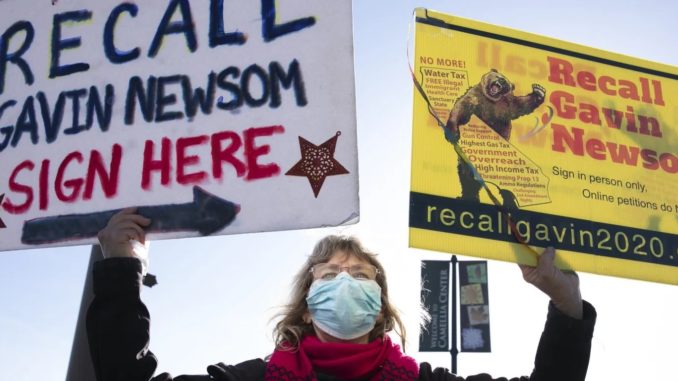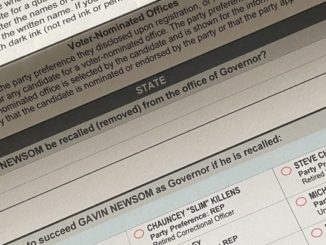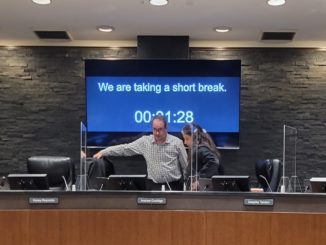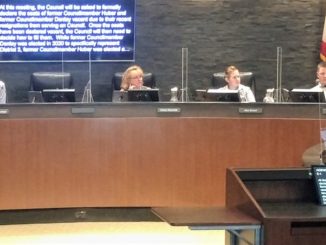
By Laurel Rosenhall for CalMatters
CalMatters is an independent public journalism venture covering California state politics and government. For more info, visit calmatters.org.
Gov. Gavin Newsom is fighting for his political life. He’s working to fend off a recall that began as a far-fetched effort by Republican activists — but has turned into a credible campaign that could throw the Democrat out of office.
It’s hard to fathom in this deep blue state where Newsom clobbered his 2018 GOP opponent, although his job approval among voters has plunged from its high in the early months of the pandemic. But the coronavirus pandemic shifted California’s political landscape in two significant ways: It prompted a judge to give recall supporters more time to collect signatures — keeping their campaign alive long enough to gain momentum — and it led Newsom to enact a slew of new restrictions to curb the spread of the virus that have frustrated some Californians and energized recall backers.
The recall petition doesn’t say a word about the pandemic — it was written before the virus upended normal life. But it gained a surge of signatures after news broke in November that a maskless Newsom joined lobbyists for a dinner party at the posh French Laundry restaurant, even though he was telling Californians to mask up and avoid socializing. The count grew as the state’s unemployment system paid out billions to fraudsters, and its chaotic COVID vaccine distribution left people scrambling for shots. With many schools, churches and businesses closed by Newsom’s stay-at-home orders, the recall that began as a conservative rebuke of his progressive policies has morphed into a referendum on his pandemic response.
So is it election year again in California? Will you be asked to toss a governor just a year shy of the end of his term? It seems likely. Recall supporters say they collected more than enough signatures necessary by the March 17 deadline to get it on the ballot. Here’s everything you need to know about recall elections in the Golden State.
How does a recall work anyway?
California is one of 19 states that allow voters to remove state officials before the end of their term. No reason is necessary — the only requirement to put a recall on the ballot is enough voter signatures. That number must be 12 percent of voters in the last election for the office, and must include voters in at least five counties. The magic number for Newsom’s would-be recallers: 1,495,709 valid signatures.
Election officials will likely announce in late April if the recall campaign submitted enough valid signatures to qualify for the ballot. If it does:
- An election would be held later this year. A date depends on when state officials complete various preliminary steps, but would likely be in the fall.
- Voters would be asked two questions: Do they want to recall Newsom, yes or no? And, if more than 50 percent of voters say “yes,” who should replace him?
This is where things get strange. There’s no limit on the number of candidates who can run to replace an official on a recall ballot. And whoever gets the most votes wins — even without a majority. So it’s entirely possible that someone could be elected in a recall while winning less than half the votes. That’s what happened in 2003, when then-Gov. Gray Davis was recalled by 55 percent of voters. More than 100 people ran to replace him, carving up the votes and allowing action movie star Arnold Schwarzenegger to win with 48.6 percent support.
How do officials verify signatures on recall petitions?
California has a long-established procedure for making sure that the people who sign petitions are who they say they are. Signature verification takes place at the registrar of voters for each of California’s 58 counties.
First, county election officials manually count the number of signatures that have been turned in. Then, they look at each signature and match it against the signature on a voter’s registration card. Finally, they check their work, said Neal Kelley, Orange County’s registrar of voters.
“It’s a pretty labor-intensive process,” he said. “People don’t realize the amount of time that goes into ensuring that it’s right.”
Kelley’s office has 15 people who do this job, each one assigned a batch of petitions. When they examine signatures, they’re supposed to look at the slant of the handwriting, the spacing between letters, and other factors — including how t’s are crossed and the shape of the loop on a g or a j. If a voter’s signature on the petition is significantly different from what’s on their registration card, it doesn’t count.
Elections officials also make sure each voter is only counted once. As they go through the petitions, they make notes in their computer system to keep track of voters that signed a petition and strike any duplicates.
Then counties report to the Secretary of State how many signatures they received and how many were invalid. After they finish this step (by April 29 for the Newsom recall), voters have 30 days to remove their signatures from the petitions if they want.
The Newsom recall campaign has been doing its own verification process before submitting signatures to the counties, said campaign consultant Dave Gilliard. That’s likely helped it achieve a high rate of valid signatures — about 84 percent percent.
That hasn’t stopped some conservatives from sowing doubts about California’s signature verification process as they tried to gin up support for the recall. GOP Rep. Darrell Issa of Vista told Politico he believes Democrats will “lie, cheat and steal” to manipulate the signature count, though he had no evidence of it. Numerous Republican politicians shared a false statement actor Kevin Sorbo posted on Twitter, claiming that California election officials checked signatures on the recall petitions, but not on mail-in ballots.
The signature verification process for mail-in ballots is the same as it is for petitions, Kelley said. And Gilliard, the veteran GOP consultant working on the recall, said he has confidence in elections officials.
“The system in California has always been very straight forward,” he said. “I don’t think the registrars will play games.”
Who’s behind the effort to throw Newsom out of office?
Republican activists have been trying to recall Newsom since shortly after he was inaugurated in January 2019. Five attempts failed to get enough signatures. But a sixth try, led by a retired sheriff’s deputy named Orrin Heatlie, gained momentum after a judge granted supporters extra time to collect signatures due to the stay-at-home order at the start of the pandemic.
Heatlie’s petition cites common conservative criticisms of California: high taxes, rampant homelessness, immigrant-friendly policies, and Newsom’s move to halt executions despite voters’ past support for the death penalty. Political consultants who worked on the 2003 recall of Gray Davis mailed the petition to potential supporters, an unusual technique that reflects constraints of signature-gathering amid a pandemic.
Heatlie, a Republican who lives in Folsom, calls his campaign a nonpartisan effort and says it includes former Democrats who have lost faith in Newsom. “This is a movement that has brought people together throughout the state and unified people from all walks of life,” Heatlie said in an interview.
A few Silicon Valley tech executives who previously donated to Democrats now support the recall. But the campaign’s largest funders and most visible backers are Republicans. Supporters include wealthy businessmen and established GOP politicians, as well as far-right extremists who have peddled misinformation.

Newsom spokesman Dan Newman calls recall supporters “a strange mishmash of people who are motivated for different reasons … . You’ve got some pro-Trump, anti-mask, anti-vaccine extremists, along with opportunistic and ambitious Republican politicians who would like to be governor.”
How are Democrats responding?
For months, Newsom deflected reporters’ questions about the recall, saying simply that he’s focused on his job as governor — working to improve vaccine distribution, reopen schools and help small businesses.
That changed in early March. Newsom used his unusual State of the State speech to lob a high-profile attack on his opponents, and then, a few days later, launched an official campaign to fight the recall. He promptly made the rounds on national television as California and national Democrats closed ranks to support him. Newsom’s strategy in a state that twice resoundingly rejected former President Donald Trump: Unite Democrats by portraying the recall as a fringey MAGA-inspired movement full of QAnon conspiracy theorists and anti-vaxxers.
An early attempt to push that message flopped in the aftermath of Trump loyalists’ Jan. 6 insurrection at the U.S. Capitol. California Democrats held a press conference alleging links between the rioters and recall supporters, and calling the recall campaign a “California Coup.” Journalists immediately pointed out that a coup is an illegal seizure of power — while a recall is a democratic procedure enshrined in the California Constitution.
The California Democratic Party’s leader quickly walked back the “coup” comparison. But Democrats will continue tying the recall to Trump and the far right, given that the former president is deeply unpopular in California. That may be enough for Newsom to beat back the recall.
Disaffected Democrats would have to support the recall in droves to make it successful in a state where just 24 percent of voters are registered Republicans and the GOP hasn’t won a statewide contest since 2006. Though they tend to vote for Democrats, roughly a quarter of California voters are not registered with either major party. So a key factor will be how much support Newsom hangs onto from liberal voters who don’t feel loyalty to him or the Democratic party.
Registered voters in CA
So is Newsom’s support eroding?
Newsom’s popularity skyrocketed early in the pandemic, with 63 percent of likely voters telling the Public Policy Institute of California that they approved of his job performance in May. Though his ratings have since dropped, Newsom remains far more popular than Gray Davis was at the same point in his recall campaign.
What Newsom has to worry about are voters like Jennifer Harris, who lives in Encinitas. She said she registered as a Democrat at age 18 and voted for Newsom in 2018, the same year she ran for school board as an endorsed Democrat. She supported Newsom’s actions early in the pandemic, including his first stay-at-home order. But as the pandemic dragged on, she saw little logic in the government’s rules to ban playgrounds and outdoor dining. And she grew unbearably frustrated with the closure of her kids’ public school — while many private schools (including the one Newsom’s children attend) remained open.
“The policy has not necessarily been good for the people that the Democratic Party says it’s supposed to be representing, which is the working class and the middle class,” Harris said. In the fall, she changed her voter registration to nonpartisan and signed the petition to recall Newsom.
College-educated suburban white women like Harris will be a critical constituency if the recall gets on the ballot, said Mike Madrid, a GOP political consultant with expertise in voter behavior. It’s a group that has traditionally supported Newsom, especially in coastal counties. “If they lose that base,” he said, “then it becomes a race.”
Polls show that Newsom is losing support among women and people who have kids at home. In May of 2020, PPIC found that 70 percent of female likely voters and 58 percent of likely voters with children in their household approved of Newsom’s job performance. By January that dropped to 57 percent of female likely voters and 49 percent of those living with kids.
Who might run to replace Newsom?
John Cox, a Republican businessman who lost to Newsom in 2018; Kevin Faulconer, the Republican former mayor of San Diego; and Doug Ose, a GOP former congressman from the Sacramento area have said they’re in. Ric Grenell, a former Trump official from Palm Springs, has hinted that he may run.
After the recall qualifies for the ballot, many other candidates will likely emerge as well. When Gray Davis was recalled in 2003, 135 people ran to replace him — including political novices like child actor Gary Coleman and pornographer Larry Flynt.
Former Facebook executive Chamath Palihapitiya said on his podcast that he would put his name on the ballot if the Newsom recall qualifies, but then walked it back a couple weeks later, saying he’s not ready to run. He isn’t registered with either party, but has donated to Democrats, and criticizes the governor for California’s slow vaccine rollout and high taxes.
It’s not clear right now if any Democrats would run to replace Newsom. “Anything and everything is on the table,” California Democratic Party leader Rusty Hicks said in January.
One theory is that Newsom would be better positioned to beat back the recall if the options to replace him are too conservative for most California voters. “If they want to hold onto the governorship … it would be in Democrats’ best interests not to put up an alternate candidate,” said Democratic political consultant Marva Diaz, an editor of the nonpartisan California Targetbook. That would allow Democrats to focus on telling voters to vote “no” on the recall, and allow them to steer clear of a confusing message like, “Vote no on the recall, but if you vote yes, vote for …”
The other theory? “It would be political malpractice not to have a Democrat on the ballot on the second question” as insurance if Newsom’s numbers worsen, said Mike Madrid, a GOP political consultant not involved in the recall.
Dave Gilliard, a Republican consultant working on the recall campaign, anticipates a large field of candidates from across the political spectrum: “Once it’s apparent that the recall is going to be on the ballot, I think there will be major candidates from all parties, even independents. Voters will have lots of choices. I don’t think either party can control who will run and not run.”
Are recalls rare?
Attempts to recall politicians are extremely common in California, and growing more common nationwide. Successful recalls remain rare.
The only California governor ever recalled — and just the second nationwide — was Gray Davis. At the start of his second term, the Democrat faced the wrath of voters over his handling of the electricity crisis, a massive state deficit and an increase in vehicle license fees. Fueling the campaign: a $2 million donation from GOP Rep. Darrell Issa.
The real game-changer, of course, was the candidacy of Arnold Schwarzenegger.
Already famous worldwide, the actor and body-builder had been laying the groundwork for entering politics by sponsoring a ballot measure for after-school programs. He was a Republican with a bipartisan image, married to Maria Shriver, niece of Democratic former President John F. Kennedy. And he infused his campaign with celebrity: announcing his candidacy to host Jay Leno on “The Tonight Show”, dancing to “We’re Not Gonna Take It” at a rally with Twisted Sister, and inspiring plenty of parodies.
Since then, only one other gubernatorial recall has made the ballot in the U.S. — the 2012 attempt to throw Wisconsin Gov. Scott Walker out of office. It failed.




What a monumental waste of effort. There are bazillions of other causes to mount that are not petty and politically motivated. So you don’t like Newsome. I have not cared for most governors of this state. My personal opinions did not move me to RECALL any of them. I use the ballot box.